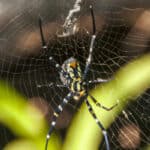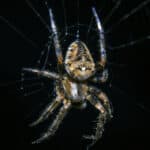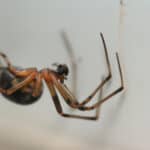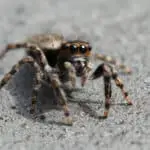Have you ever killed a spider and wondered if it was pregnant? It’s a common concern, but what happens when you kill a pregnant spider? The answer is not as straightforward as you might think. Killing a pregnant spider can have several consequences, affecting not only the mother but also her unborn spiderlings. In this article, I’ll explain the potential risks of killing a pregnant spider and what you can do to prevent infestations.
Understanding spider reproduction is crucial to understanding the consequences of killing a pregnant spider. Spiders tend to lay many eggs, and it’s a survival strategy to ensure that at least some of their offspring survive. Different types of spiders have different reproductive strategies, but in general, female spiders lay eggs that hatch into spiderlings. These spiderlings are born with all the necessary organs to survive and grow, and they rely on their mother for protection and food until they’re old enough to fend for themselves. If you kill a pregnant spider, you risk disrupting this delicate balance and potentially causing an infestation.
So, what happens when you kill a pregnant spider? The answer depends on the type of spider and the stage of pregnancy. Some spiders lay their eggs in an egg sac, while others carry their eggs on their back. Killing a spider with an egg sac can scatter the eggs, potentially leading to an infestation. Killing a spider with babies on its back can also cause the babies to scatter, and smashing a pregnant spider can result in a mess of eggs scattered around your home. In the next section, we’ll explore the different types of pregnant spiders and the risks associated with killing them.
Key Takeaways
- Killing a pregnant spider can lead to the dispersion of spiderlings and the potential risk of infestation.
- Different types of spiders have different reproductive strategies, but in general, female spiders lay eggs that hatch into spiderlings.
- To prevent spider infestations, it’s best to avoid killing spiders and instead use humane methods to remove them from your home.

Understanding Spider Reproduction
As an AI language model, I do not have personal pronouns, but I will try to use a friendly and conversational tone throughout this article to engage with the reader. In this section, we will discuss the basics of spider reproduction. We will cover the spider mating process and pregnancy in spiders.
Spider Mating Process
The spider mating process is fascinating and intricate. It involves the male spider using his pedipalps to transfer sperm to the female spider’s reproductive openings. The male spider has to approach the female spider carefully to avoid being eaten. Once he is close enough, he will use his pedipalps to transfer a sperm packet to the female spider’s genital opening.
Pregnancy in Spiders
After mating, female spiders lay eggs. The gestation period varies depending on the species, but it can range from a few weeks to several months. Some species of spiders can lay hundreds or even thousands of eggs at once.
To determine if a spider is pregnant, you can look for a swollen abdomen or the presence of an egg sac. For example, the Black Widow spider will either have a large abdomen or an egg sac close by to tell if the spider is gravid or not.
Conclusion
In conclusion, understanding spider reproduction is important if you want to identify pregnant spiders. Knowing how spiders mate and produce eggs can help you identify the signs of pregnancy, such as a swollen abdomen or the presence of an egg sac. It is essential to avoid killing pregnant spiders to prevent the dispersion of spiderlings and the potential risk of infestation. Additionally, disrupting spider reproduction has an ecological impact, and killing spiders raises ethical concerns.
Different Types of Pregnant Spiders
Spiders are fascinating creatures, and their reproduction process is no exception. There are many different types of spiders, and each species has its unique characteristics when it comes to pregnancy. In this section, we will explore the different types of pregnant spiders and what happens if you kill them.
Wolf Spiders
Wolf spiders are known for their large size and hunting abilities. They are also one of the most common types of spiders found in homes. Female wolf spiders carry their eggs with them in a sac attached to their spinnerets. When the eggs are ready to hatch, the female wolf spider will release them from the sac and carry them on her back until they are ready to fend for themselves.
Jumping Spiders
Jumping spiders are small but mighty. They are known for their incredible jumping ability and their unique eye arrangement. Female jumping spiders carry their eggs in a silk sac attached to their spinnerets. When the eggs are ready to hatch, the female jumping spider will guard the sac until the spiderlings emerge.
Brown Recluse Spiders
Brown recluse spiders are venomous and can be dangerous to humans. Female brown recluse spiders carry their eggs in a silk sac attached to their spinnerets. When the eggs are ready to hatch, the female brown recluse spider will abandon the sac, and the spiderlings will fend for themselves.
Black Widow Spiders
Black widow spiders are also venomous and can be dangerous to humans. Female black widow spiders carry their eggs in a silk sac attached to their spinnerets. When the eggs are ready to hatch, the female black widow spider will guard the sac until the spiderlings emerge.
Huntsman Spiders
Huntsman spiders are known for their large size and hunting abilities. Female huntsman spiders carry their eggs in a sac attached to their spinnerets. When the eggs are ready to hatch, the female huntsman spider will release them from the sac and carry them on her back until they are ready to fend for themselves.
House Spiders
House spiders are one of the most common types of spiders found in homes. Female house spiders carry their eggs in a sac attached to their spinnerets. When the eggs are ready to hatch, the female house spider will guard the sac until the spiderlings emerge.
In conclusion, different types of spiders have unique characteristics when it comes to pregnancy. It is essential to understand these characteristics to appreciate these fascinating creatures fully.
What Happens When You Kill a Pregnant Spider
As someone who cares about the environment, I always try to avoid killing spiders. However, I understand that sometimes it can be necessary, especially when dealing with venomous species. But what happens when you kill a pregnant spider? Let’s explore the immediate aftermath and long-term impact of this action.
Immediate Aftermath
When you kill a pregnant spider, the most immediate consequence is the dispersion of spiderlings. Depending on the species, a spider can lay hundreds of eggs at once. If the eggs were close to hatching, killing the mother can cause the baby spiders to scatter everywhere. This can be dangerous if you’re dealing with venomous species, as the spiderlings could bite you or your pets.
Long-Term Impact
Killing a pregnant spider can have long-term effects on the ecosystem. Spiders play an important role in controlling insect populations, and disrupting their reproduction can have a ripple effect on the food chain. Additionally, some spider species are endangered, and killing pregnant individuals can further threaten their conservation.
If you’re dealing with a spider infestation, there are alternatives to killing them. You can use humane traps to catch and release them outside, or hire a pest control professional who specializes in spider removal. By taking these steps, you can avoid harming spiders and contribute to a healthier ecosystem.
Preventing Spider Infestations
As killing a pregnant spider can lead to the dispersion of spiderlings and the potential risk of infestation, it is best to avoid killing spiders altogether. Here are some pest control methods that can help prevent spider infestations:
Pest Control Methods
- Keep your home clean and clutter-free. Spiders like to hide in dark, cluttered spaces, so keeping your home clean and organized can help deter them from entering.
- Seal any cracks or gaps in your home’s foundation, walls, and windows. This can help prevent spiders from entering your home.
- Use spider traps or sticky traps to catch spiders. These traps can be placed in areas where spiders are commonly found, such as corners, behind furniture, and in basements.
- Use spider repellents, such as essential oils or vinegar, to deter spiders from entering your home. These repellents can be sprayed in areas where spiders are commonly found.
- Vacuum regularly to remove spider webs and eggs. This can help prevent spiders from laying eggs and building webs in your home.
- Use insecticides or pesticides to kill spiders. However, it is important to use these products safely and according to the manufacturer’s instructions.
By following these pest control methods, you can help prevent spider infestations in your home. Remember, prevention is key when it comes to dealing with spiders and other pests.
Conclusion
In conclusion, killing a pregnant spider can have unintended consequences on the spider population and the delicate balance of ecosystems. It can result in the destruction of her eggs or cocoon, depending on the stage of her pregnancy. Therefore, it is important to consider alternatives to killing spiders, especially if they are pregnant or carrying their babies.
If you come across a spider with babies on its back, it is best to catch and release it outside. Most spiders are harmless and play an important role in controlling insect populations. Killing them can upset the natural balance of ecosystems and lead to an increase in pest populations.
It is also important to be aware of the signs of spider pregnancy, such as an enlarged abdomen and the presence of an egg sac. By identifying pregnant spiders, you can take steps to avoid harming them and their offspring.
In summary, while killing a pregnant spider may seem like a small action, it can have significant consequences. By taking a more humane approach to dealing with spiders, we can help protect the delicate balance of our ecosystems and ensure the continued health of our planet.
Frequently Asked Questions
What happens to the spider’s babies if you kill a pregnant spider?
When you kill a pregnant spider, its babies may scatter away. Spiders lay many eggs, and it’s a survival strategy to ensure that at least a few survive. Therefore, if you kill a pregnant spider, it’s possible that its babies may survive and continue to populate the area. On the other hand, killing a pregnant spider may also reduce the spider population in the area, which can have unintended consequences on the delicate balance of ecosystems.
How do you identify if a spider is pregnant?
It can be challenging to identify if a spider is pregnant, but there are a few things you can look for. Pregnant spiders tend to be larger than non-pregnant spiders. They may also have a rounder abdomen, which can be an indication of a developing egg sac. Additionally, some species of spiders may exhibit certain behaviors when they are pregnant, such as building a web to protect their eggs.
Is it safe to kill a spider with babies?
Killing a spider with babies is not recommended. If you kill a spider with babies, the babies may scatter away, which can lead to an increase in the spider population in the area. Additionally, killing a spider with babies may also have unintended consequences on the delicate balance of ecosystems. Therefore, it’s best to avoid killing spiders with babies whenever possible.
What are the consequences of killing a pregnant spider?
Killing a pregnant spider can have unintended consequences on the spider population and the delicate balance of ecosystems. If you kill a pregnant spider, its babies may scatter away, which can lead to an increase in the spider population in the area. Alternatively, killing a pregnant spider may reduce the spider population in the area, which can have unintended consequences on the delicate balance of ecosystems.
How can you get rid of a pregnant spider without harming it?
If you need to get rid of a pregnant spider, there are a few things you can do to avoid harming it. First, you can try to catch the spider and release it outside. Alternatively, you can use a spider catcher, which is a device that allows you to catch and release spiders without harming them. Finally, you can try to deter spiders from entering your home by sealing up cracks and crevices and keeping your home clean and free of clutter.
What should you do if you accidentally kill a pregnant spider?
If you accidentally kill a pregnant spider, there’s not much you can do to reverse the damage. However, you can take steps to prevent it from happening again in the future. For example, you can try to avoid killing spiders whenever possible, or you can take steps to deter spiders from entering your home in the first place. Additionally, you can try to educate others about the importance of preserving the spider population and the delicate balance of ecosystems.








